Unit 5---英汉对比与篇章翻译
Unit5翻译
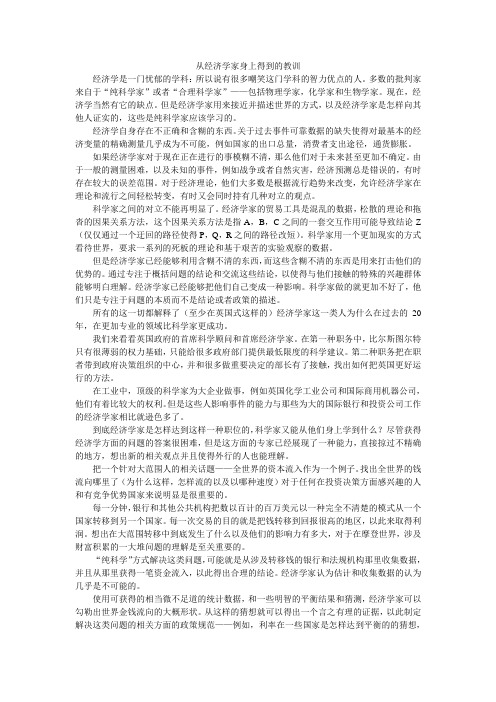
从经济学家身上得到的教训经济学是一门忧郁的学科:所以说有很多嘲笑这门学科的智力优点的人。
多数的批判家来自于“纯科学家”或者“合理科学家”——包括物理学家,化学家和生物学家。
现在,经济学当然有它的缺点。
但是经济学家用来接近并描述世界的方式,以及经济学家是怎样向其他人证实的,这些是纯科学家应该学习的。
经济学自身存在不正确和含糊的东西。
关于过去事件可靠数据的缺失使得对最基本的经济变量的精确测量几乎成为不可能,例如国家的出口总量,消费者支出途径,通货膨胀。
如果经济学家对于现在正在进行的事模糊不清,那么他们对于未来甚至更加不确定。
由于一般的测量困难,以及未知的事件,例如战争或者自然灾害,经济预测总是错误的,有时存在较大的误差范围。
对于经济理论,他们大多数是根据流行趋势来改变,允许经济学家在理论和流行之间轻松转变,有时又会同时持有几种对立的观点。
科学家之间的对立不能再明显了。
经济学家的贸易工具是混乱的数据,松散的理论和拖沓的因果关系方法,这个因果关系方法是指A,B,C之间的一套交互作用可能导致结论Z (仅仅通过一个迂回的路径使得P,Q,R之间的路径改短)。
科学家用一个更加现实的方式看待世界,要求一系列的死板的理论和基于艰苦的实验观察的数据。
但是经济学家已经能够利用含糊不清的东西,而这些含糊不清的东西是用来打击他们的优势的。
通过专注于概括问题的结论和交流这些结论,以使得与他们接触的特殊的兴趣群体能够明白理解。
经济学家已经能够把他们自己变成一种影响。
科学家做的就更加不好了,他们只是专注于问题的本质而不是结论或者政策的描述。
所有的这一切都解释了(至少在英国式这样的)经济学家这一类人为什么在过去的20年,在更加专业的领域比科学家更成功。
我们来看看英国政府的首席科学顾问和首席经济学家。
在第一种职务中,比尔斯图尔特只有很薄弱的权力基础,只能给很多政府部门提供最低限度的科学建议。
第二种职务把在职者带到政府决策组织的中心,并和很多做重要决定的部长有了接触,找出如何把英国更好运行的方法。
新视野大学英语(第二版)课文翻译及练习答案unit5
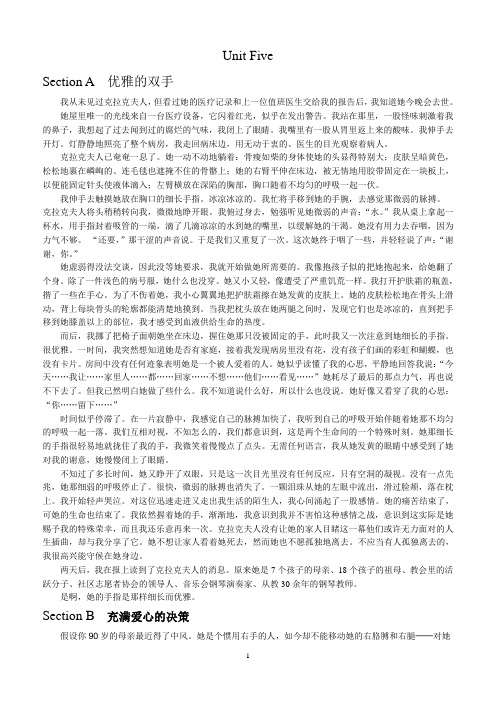
Unit FiveSection A 优雅的双手我从未见过克拉克夫人,但看过她的医疗记录和上一位值班医生交给我的报告后,我知道她今晚会去世。
她屋里唯一的光线来自一台医疗设备,它闪着红光,似乎在发出警告。
我站在那里,一股怪味刺激着我的鼻子,我想起了过去闻到过的腐烂的气味,我闭上了眼睛。
我嘴里有一股从胃里返上来的酸味。
我伸手去开灯。
灯静静地照亮了整个病房,我走回病床边,用无动于衷的、医生的目光观察着病人。
克拉克夫人已奄奄一息了。
她一动不动地躺着:骨瘦如柴的身体使她的头显得特别大;皮肤呈暗黄色,松松地裹在嶙峋的、连毛毯也遮掩不住的骨骼上;她的右臂平伸在床边,被无情地用胶带固定在一块板上,以便能固定针头使液体滴入;左臂横放在深陷的胸部,胸口随着不均匀的呼吸一起一伏。
我伸手去触摸她放在胸口的细长手指。
冰凉冰凉的。
我忙将手移到她的手腕,去感觉那微弱的脉搏。
克拉克夫人将头稍稍转向我,微微地睁开眼。
我俯过身去,勉强听见她微弱的声音:“水。
”我从桌上拿起一杯水,用手指封着吸管的一端,滴了几滴凉凉的水到她的嘴里,以缓解她的干渴。
她没有用力去吞咽,因为力气不够。
“还要,”那干涩的声音说。
于是我们又重复了一次。
这次她终于咽了一些,并轻轻说了声:“谢谢,你。
”她虚弱得没法交谈,因此没等她要求,我就开始做她所需要的。
我像抱孩子似的把她抱起来,给她翻了个身。
除了一件浅色的病号服,她什么也没穿。
她又小又轻,像遭受了严重饥荒一样。
我打开护肤霜的瓶盖,揩了一些在手心。
为了不伤着她,我小心翼翼地把护肤霜擦在她发黄的皮肤上。
她的皮肤松松地在骨头上滑动,背上每块骨头的轮廓都能清楚地摸到。
当我把枕头放在她两腿之间时,发现它们也是冰凉的,直到把手移到她膝盖以上的部位,我才感受到血液供给生命的热度。
而后,我挪了把椅子面朝她坐在床边,握住她那只没被固定的手,此时我又一次注意到她细长的手指。
很优雅。
一时间,我突然想知道她是否有家庭,接着我发现病房里没有花,没有孩子们画的彩虹和蝴蝶,也没有卡片。
最新初中英语七年级下 Unit 5 Section B 2b 参考译文
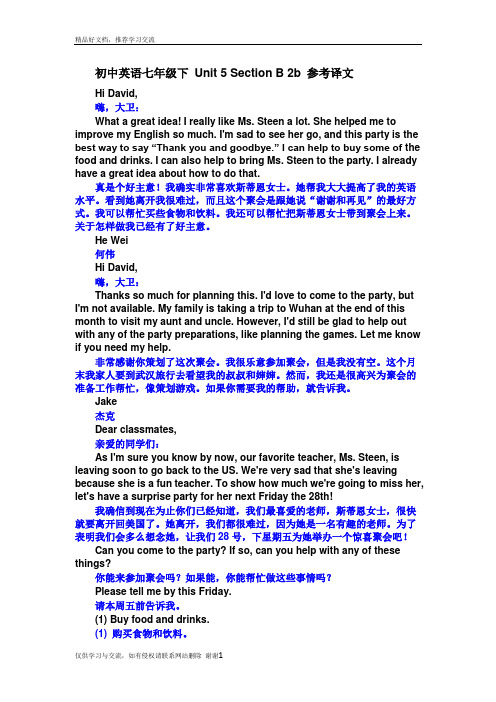
初中英语七年级下Unit 5 Section B 2b 参考译文Hi David,嗨,大卫:What a great idea! I really like Ms. Steen a lot. She helped me to improve my English so much. I'm sad to see her go, and this party is the best way to say “Thank you and goodbye.” I can help to buy some of the food and drinks. I can also help to bring Ms. Steen to the party. I already have a great idea about how to do that.真是个好主意!我确实非常喜欢斯蒂恩女士。
她帮我大大提高了我的英语水平。
看到她离开我很难过,而且这个聚会是跟她说“谢谢和再见”的最好方式。
我可以帮忙买些食物和饮料。
我还可以帮忙把斯蒂恩女士带到聚会上来。
关于怎样做我已经有了好主意。
He Wei何伟Hi David,嗨,大卫:Thanks so much for planning this. I'd love to come to the party, but I'm not available. My family is taking a trip to Wuhan at the end of this month to visit my aunt and uncle. However, I'd still be glad to help out with any of the party preparations, like planning the games. Let me know if you need my help.非常感谢你策划了这次聚会。
Unit5Classroom课文原文与翻译(素材)鲁科版(五四学制)英语三年级上册

鲁科版英语(五四学制)三年级上册课文原文及翻译Unit5英汉对照版Unit 5 Classroom 第五单元教室Lesson 1 This is my desk.第一课这是我的课桌。
1. Listen and say.听一听,说一说This is our classroom.这是我们的教室。
Oh! Our new classroom.哦,我们的新教室。
This is my desk.这是我的课桌。
This is your chair.这是你的椅子。
That s my desk.那是我的课桌。
That s my chair.那是我的椅子。
2. Let s talk.一起说Danny, this is my desk.丹尼,这是我的课桌。
That s your desk, Danny.丹尼,那是你的课桌。
Oh! This is my desk.哦!这是我的课桌。
3. Listen and read.听一听,读一读Hh Ii Jj KkUnit 5 Lesson 2 I have a new pen.第二课我有一支新钢笔。
1. Listen and say.听一听,说一说Look! I have a schoolbag.看!我有一个书包。
I have a book.我有一本书。
I have a pencil.我有一支铅笔。
Me, too.我也有。
I have a new pen.我有一支新钢笔。
It s nice! 它很漂亮!2. Let s talk.一起说I have a book.我有一本书。
Me, too.我也有。
I have a new pencil.我有一支新铅笔。
It s nice! 它很漂亮!Unit 5 Lesson 3 What s this? 第三课这是什么?1. Listen and say.听一听,说一说What s this?这是什么?It s a ruler.是一把尺子。
[英语四六级]Unit 5---英汉对比与篇章翻译
![[英语四六级]Unit 5---英汉对比与篇章翻译](https://img.taocdn.com/s3/m/3990187e3b3567ec102d8af8.png)
Two Types of Transfer
• Negative Transfer (负迁移) Errors arise from analogy. 类推会产生错误。
• Positive Transfer (正迁移) Errors decrease by analysis. 分析能减少错误。
Keen awareness of the similarities and differences between the two languages can facilitate FL learning.
Topic-prominent Subject-prominent Language Language 话题突出型语言 主语突出型语言
Chinese Order of Linguistic Elements
Relatively fixed (相对固定) Order of time (时间先后顺序)
Examples of Negative Transfer
1. The writer likes writing at light (night). 【语音 迁移】 2. He only eat two meal a day. 【词形迁移】
Difference Between
Comparative Study and Contrastive Study Comparative Study lays emphasis on the similarities between languages and applies the diachronic method of research. Contrastive Study lays emphasis on the differences between languages and applies the synchronic method of research.
PEP五年级英语Unit5课文翻译及知识点辅导

Main scence萨拉:有这么多幅画!张鹏:我爸爸很会画画。
迈克:多漂亮的照片啊!张鹏:那是我奶奶的花园。
里面有许多漂亮的花。
子普:房间里有什么?祖姆:在床的旁边有一张桌子。
PartA let’s talk萨拉:你的房间真漂亮!张鹏:谢谢。
迈克:有张大床。
张鹏:是的。
我喜欢我的床。
迈克:还有一张漂亮的照片。
萨拉:哇!你看起来真酷!张鹏:谢谢你。
嘿,我的计算机在这儿的课桌上。
我们一起玩吧!描述这幅图画:张鹏:图画里有张课桌。
萨拉:课桌上有个盘子。
张鹏:盘子上有根香蕉。
Let’s play张鹏:我的房间里有一个时钟。
约翰:我的房间里有一个时钟和一株植物。
埃米:我的房间里有一个时钟、一株植物和一张照片。
Part B let’s talk张鹏:这是客厅。
迈克:哇!这里有这么多幅画。
张鹏:是的。
我爸爸很会画画。
萨拉:这里还有这么多植物。
张鹏:它们是我奶奶的植物。
在我爷爷奶奶的房子前面有一个花园。
花园里有许多花。
萨拉:太棒了!看上面的图画。
在图画里你还能看到什么?埃米:图画里有两只狗。
奥利弗:有一些鱼。
Read and write给罗宾的一封电子邮件寄给:robin@来自:jones@十二月二十号亲爱的罗宾:我是一凡的美术老师。
我刚刚搬进一所老房子。
房间很脏。
在地板上有铅笔和蜡笔。
到处有图画和照片。
哦,不!我看到一只老鼠在我的计算机后面!请帮助我。
我住在自然公园附近。
请快点!琼斯先生Storytime1.在和旁边有一个易拉罐。
他很难过。
易拉罐:你能帮帮我吗?我很想回家。
鸟:对不起。
我很忙。
2.一只淘气的熊踢了易拉罐。
熊:哈哈!易拉罐:噢,不要!3.易拉罐从兔子和猴子上方飞过。
易拉罐:救命!猴子:看那个可怜的易拉罐。
兔子:快点吧!我们上学迟到了。
4.易拉罐落在了两条鱼中间。
鱼先生:来了个易拉罐。
鱼女士:我们把它给祖姆吧。
他能帮忙。
5.祖姆接住了易拉罐。
祖姆:让我帮你吧。
易拉罐:谢谢你。
家,甜蜜的家。
sad 伤心的,难过的can易拉罐busy忙碌的naughty 淘气的kick踢fly-flies over飞过poor可怜的come on快点catch-catches抓住,接住give …to… 把……给……注:1.an apple/an orange/an umbrella(伞)/an eggan English book/ an old house2.不可数名词:water/juice/milk/tea/Coke/Cola/coffeemeat(肉)/chicken/fish/soup/rice/beef/bread注:人+have/has+物品。
新编大学英语综合教程Unit 5-课文翻译
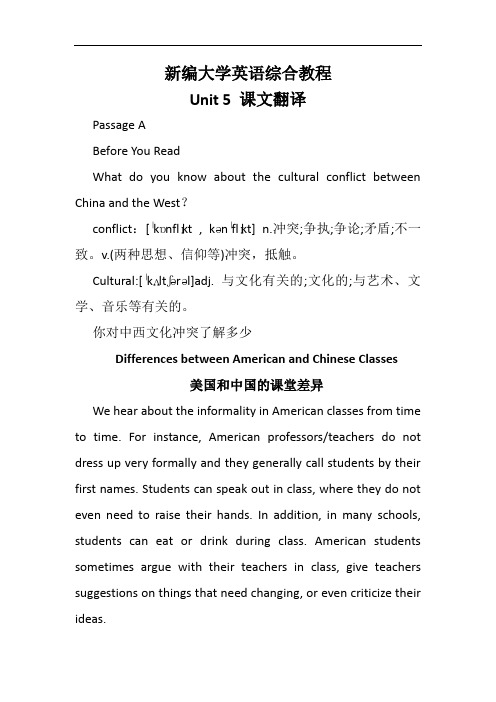
新编大学英语综合教程Unit 5 课文翻译Passage ABefore You ReadWhat do you know about the cultural conflict between China and the West?conflict:[ˈkɒnflɪkt , kənˈflɪkt] n.冲突;争执;争论;矛盾;不一致。
v.(两种思想、信仰等)冲突,抵触。
Cultural:[ˈkʌltʃərəl]adj. 与文化有关的;文化的;与艺术、文学、音乐等有关的。
你对中西文化冲突了解多少Differences between American and Chinese Classes美国和中国的课堂差异We hear about the informality in American classes from time to time. For instance, American professors/teachers do not dress up very formally and they generally call students by their first names. Students can speak out in class, where they do not even need to raise their hands. In addition, in many schools, students can eat or drink during class. American students sometimes argue with their teachers in class, give teachers suggestions on things that need changing, or even criticize their ideas.hear about 得知; 听到关于from time to time 不时地;间或;偶尔For instance 例如;譬如。
最新人教版九年级英语Unit5课文翻译

人教版新目标初中英语九年级Unit 5课文翻译What are the shirts made of? 衬衫是由什么制成的?Role-play the conversation. 分角色表演以下对话。
Pam: China is famous for tea, right?Liu Jun: Yes, both in the past and now.Pam: Where is tea produced in China?Liu Jun: Well, in many different areas. For example, Anxi and Hangzhou are widely known for their tea.Pam: How is tea produced?Liu Jun: Well, as far as I know, tea plants are grown on the sides of mountains. When the leaves are ready, they are picked by hand and then are sent for processing.Pam: What happens next?Liu Jun: The tea is packed and sent to many different countries and places around China. Pam: It seems that many people all over the world drink Chinese tea.Liu Jun: Yes, people say that tea is good for both health and business!帕姆:中国的茶很有名,是吗?刘俊:是的,过去和现在都很出名。
帕姆:中国的那些地方产茶呢?刘俊:哦,很多不同地区都产茶。
unit5 课文翻译

Unit 5 THE BAND THAT WASN’T并非乐队的乐队Para 1: RecitationHave________________________________________________________________ _____________________________________________________________________ _____________________________________________________________________ _____________________________________________________________________ _____________________________________________________________________ ____Para 2:Many musicians meet and form a band because they like to write and play their own music._______________________________________________________________ 他们开始可能是一组中学生,在某个人家里排练音乐是成名的第一步。
_______________________________________________________________ Sometimes they may play to passers-by in the street or subway so that they can earn some extra money for themselves or to pay for their instruments._________________________________________________________________________________. 后来,他们可能在酒吧或者俱乐部里演出,这样他们可以得到现金。
英汉对比与翻译Unit 5

it's bad for his character.
• 他们过分纵容孩子, 这对孩子的性格 有不良影响.
Words
• indulge: • I'm really going to indulge
myself tonight with a bottle of champagne.
• 今天晚上我可真要放纵一下自己, 喝他一瓶香槟.
Words
• indulge: • (b) allow (sb) to proceed without interrupting or hindering him 容许 或迁就(某人)做要做的事: : • If you will indulge me for one
moment, I think I can explain the matter to you.
Words
• indulge: • 1.(a)~ oneself/sb (with sth) allow oneself/sb to have whatever one/he likes or wants 放纵自己[某 人] : • They indulge their child too much;
Comparative Translation
毛海燕
Unit Five
Letter
Sourse language:
• 英国诗人P.B. Shelley (1792-1822)给 英国诗人John Keats (1795-1821)的一 封信。
Sourse language:
• Shelley, Per·cy Bysshe (1792-1822) a British poet of the Romantic Movement, who disliked religion and believed strongly in political freedom. • His most famous works were written after 1818 when he went to live in Italy with his wife Mary Shelley, and they include Adonais, written in memory of the poet John Keats, Prometheus Unbound, and To a Skylark.
Unit 5课文翻译

Unit 5课文a花钱还是存钱,学生进退维谷1. 你是不是跟我一样对“我应该花钱还是存钱”这个问题感到困惑,且有被操纵的感觉?我觉得我们从生活的环境里所获得的信息似乎是有违常识、互相矛盾的。
政府告诉我们要花钱,否则我们将永远走不出衰退;与此同时,他们又告诉我们,除非我们节省更多的钱,否则我们的国家会处于严重危险之中。
银行提供较高的利率以增加储蓄。
然后,同样是这些银行又提供信用卡让我们可以花更多的钱。
2. 这里还有一个大家熟悉的例子:如果我们不按时支付信用卡账单,我们会收到从信用卡公司发来的类似这样的令人讨厌的催缴帐单的电子邮件:不还款是不可接受的。
请立即缴付,否则后果自负!之后,一旦还款,我们就会收到一封跟进的电子邮件,语气和蔼可亲,说我们是多么宝贵的客户,并鼓励我们继续花钱。
到底哪一个描述是正确的?有麻烦的失败消费者还是宝贵的客户?这两者之间可是天壤之别!3. 自相矛盾的情况还有,我们每天都收到彼此相左的两种信息。
一种从“纵容”的角度,让我们“买东西,花钱,现在就得到它。
你需要这个!”另外一种,我们可以称之为“正直”的信息,它力劝我们:“努力工作,把钱存起来。
控制你的欲望,不要买奢侈品,不要垂涎那些你并不真正需要的东西。
”这类信息来源甚多,由学校方面的,有家长方面的,甚至还来自提及传统价值观的政治人物。
艰苦创业,忠于家庭、能推迟欲望是美国价值观的核心,它使我们的国家变得强大。
4. 但相反的信息,即那些纵容人们不断花钱的广告,无所不在。
虽然此类信息有时经过了乔装打扮,但仍随处可见,电视、电影、印刷媒介和路牌、商店,及公共汽车、火车和地铁上,比比皆是。
广告侵入了我们的日常生活。
我们时时被包围在花钱,花钱,花钱的信息中。
最近有人说:“唯一可以逃脱广告的时候是当在床上睡着时!”5. 据计算,普通当美国人到18岁时,会看过60万则广告;到40岁时,看过的广告总数近百万。
每个广告都在尽最大努力影响我们形形色色到购买决定——从我们吃的早餐麦片到我们到假期将使用哪条邮轮路线。
全新版大学英语阅读教程翻译unit 5

谢谢你,女士她是一个高大的女人,手里拿着手提包,手提包中除了铁锤和钉子什么都有。
手提包上有一根长长的带子,她就把它悬挂在肩膀上背着。
已经是大约晚上11点钟了,外面很黑,她独自一个人走着,突然一个男孩从她身后跑过来竭力地抢她的手提包。
男孩突然从后面一拉带子就断了。
但是男孩的体重和手提包的重量加在一起使他失去了平衡。
男孩并没有像他希望的那样很快的离开,而是摔倒在人行道上腿都翘了起来。
那个高大的女人仅仅是转过身来,结结实实地揍了他穿着蓝色牛仔裤的屁股。
然后她伸手拽着男孩的衬衫领把他从地上拉起来,一直摇晃他直到他的牙齿格格作响。
之后那个女人说:“小男孩,把钱包捡起来给我。
”她仍然紧紧地抓着他。
但是她尽量地弯腰允许男孩俯身捡起她的钱包。
然后她说:“难道现在你对于你自己不感到羞愧吗?被紧紧抓着衬衫,男孩说:“是的,女士。
”那个女人又问:“你为什么这么做?”男孩回答:“我不是故意的。
”女人:“你撒谎!”此时已有几个人路过,停下回头甚至驻足观看。
“如果我放开你,你会跑走吗?”女人问。
“我会,女士。
”男孩回答。
“那我还是抓着你吧,”女人说,她并没有松开男孩。
“女士,非常抱歉,”男孩低声说。
“嗯哼!你的脸脏了,我仁慈点帮你洗脸吧,难道你家里没有人提醒你洗一下脸吗?”“没有...”男孩说。
“你的脸今晚就得洗”那高大的女人说完,就开始拖着她身后被吓坏的男孩走在街上。
男孩穿着牛仔裤网球鞋,看上去只有十四五岁,却显得羸弱邋遢。
女人说,“你应该成为我的孩子,我会教你明辨是非的,至少现在能帮你洗下脸。
你饿不饿?”“不,女士”这个被抓住的男孩说道。
“我只是希望你能够放开我让我离开”“在我转过那个拐角的时候我招惹你了吗?”女人问道。
“没有,女士。
”“是你自己主动来招惹我,”女人说道。
“如果你认为,惹了我可以就这么算了,那你还是再想想吧。
这件事了了以后,先生,你就会记住我卢尔拉﹒贝茨﹒华盛顿﹒琼斯女士了。
”汗突然从这个男孩的脸上流下,他开始挣扎。
unit 5 翻译

Hints对立力量conflicting forces辉煌的往昔brilliant past glories玫瑰般的将来rosy future无可否定的局限性incontestable limitations不容置疑的无限可能性indisputable infinitude of possibilitiesKeyPeople turn themselves into two conflicting forces—conservatives and liberals, owing to their respective opposing philosophical views about life. The former are complacent with the established hierarchies while the latter strive for a new cosmos order which they believe will be superior to the previous one. They each give priorities to totally different things. The former emphasize brilliant past glories while the latter are chiefly concerned about the rosy future. The former base their views on man’s incontestable limitations while the latter stand on his indisputable infinitude of possibilities in improving and perfecting themselves. If the former go too far, they may display some nostalgia for a largely nonexistent past, which may handicap the pursuit of a still better future. If the latter go too far, they tend to cherish some dreams too romantic to be practical. If human life consists of spring, summer, autumn and winter, we are inclined to be liberals in spring and summer, but there is every likelihood that we may turn ourselves into conservatives by degrees in autumn and winter. For example, the famous modernist poet Eliot explored in his early poetry various aspects of decay of civilization in the modern Western world, but he attached much importance to stability and order in his later works.。
新视野大学英语第二册Unit5课文翻译

新视野大学英语第二册Unit5课文翻译新视野大学英语第二册Unit 5课文翻译下面是新视野大学英语第二册Unit 5课文翻译,这个单元的课文都跟对孩子的教育有关,欢迎大家阅读!新视野大学英语第二册Unit 5课文翻译篇1我女儿抽烟。
她做作业时,脚搁在前面的长凳上,计算器嗒嗒地跳出几何题的答案。
我看着那包已抽了一半、她随意扔在手边的“骆驼”牌香烟。
我拿起香烟,走到厨房里去仔细察看,那里的光线好一点──谢天谢地,香烟是有过滤嘴的。
我心里十分难过。
我想哭。
事实上,我确实哭过。
我站在炉子旁边,手里捏着一支雪白的香烟,制作得非常精致,但那可是会致我女儿于死地的东西啊。
当她抽“万宝路”及“普雷厄尔”牌香烟时,我硬起心肠,不让自己感到难过。
我认识的人当中没有人抽这两种牌子的香烟。
她不知道我父亲、也就是她外公生前抽的就是“骆驼”牌香烟。
但是在他开始抽机制卷烟之前──那时他很年轻、也很穷,眼睛炯炯有神──他抽的是用“阿尔伯特亲王牌”烟丝自己手工卷的香烟。
我还记得那鲜红的烟丝盒,上面有一张维多利亚女王丈夫阿尔伯特亲王的照片,他身穿黑色燕尾服,手里拿着一支手杖。
到40年代末、50年代初,我的家乡佐治亚州的伊腾顿已没有人再自己手工卷烟了(而且几乎没有女人抽烟)。
烟草业,再加上好莱坞电影──影片中的男女主角都是烟鬼──把像我父亲这样的人完完全全争取了过去,他们无可救药地抽烟抽上了瘾。
然而我父亲从来就没有像阿尔伯特亲王那样时髦过。
他还是一个贫穷、过于肥胖、为养活一大家人而拼命干活的男人。
他是黑人,嘴里却总叼着一支雪白的香烟。
我记不清父亲是什么时候开始咳嗽的。
也许开始时并不明显,只是早晨一下床点燃第一支香烟时才有点微咳。
到我16岁,也就是我女儿现在这般年纪时,他一呼吸就呼哧呼哧的,让人感到不安;他上楼时每走三、四级楼梯就得停下来休息一会儿,而且,他常常一连咳上一个小时。
肺部的病痛把我父亲折磨得虚弱不堪,一个严冬,他死于被称为“穷人之友” 的疾病──肺炎。
大学英语unit 5 True-Height原文与翻译
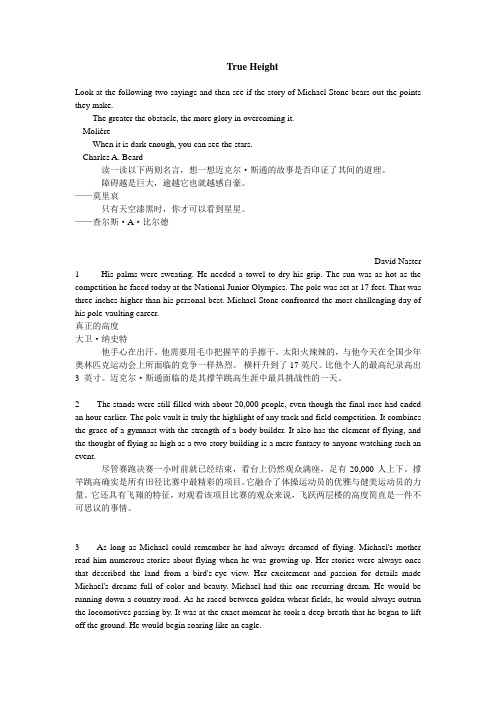
True HeightLook at the following two sayings and then see if the story of Michael Stone bears out the points they make.The greater the obstacle, the more glory in overcoming it.-- MolièreWhen it is dark enough, you can see the stars.-- Charles A. Beard读一读以下两则名言,想一想迈克尔·斯通的故事是否印证了其间的道理。
障碍越是巨大,逾越它也就越感自豪。
——莫里哀只有天空漆黑时,你才可以看到星星。
——查尔斯·A·比尔德David Naster 1 His palms were sweating. He needed a towel to dry his grip. The sun was as hot as the competition he faced today at the National Junior Olympics. The pole was set at 17 feet. That was three inches higher than his personal best. Michael Stone confronted the most challenging day of his pole-vaulting career.真正的高度大卫·纳史特他手心在出汗。
他需要用毛巾把握竿的手擦干。
太阳火辣辣的,与他今天在全国少年奥林匹克运动会上所面临的竞争一样热烈。
横杆升到了17英尺。
比他个人的最高纪录高出3 英寸。
迈克尔·斯通面临的是其撑竿跳高生涯中最具挑战性的一天。
2 The stands were still filled with about 20,000 people, even though the final race had ended an hour earlier. The pole vault is truly the highlight of any track and field competition. It combines the grace of a gymnast with the strength of a body builder. It also has the element of flying, and the thought of flying as high as a two-story building is a mere fantasy to anyone watching such an event.尽管赛跑决赛一小时前就已经结束,看台上仍然观众满座,足有20,000人上下。
Unit five中英文比较翻译

Unit five中英文对照翻译Text AYes, We Can Support Mother Earth1 Turning off the lights for an hour on March 26 is just a step to recognize that mother earth needs our help. Together we can protect earth’s precious resources by conserving developing, and spreading the word. How can you conserve this year?在 3 月26 日熄灯一小时只是我们认识到地球母亲需要我们帮助的一步。
我们可以通过节约、开发、宣传这一信息来共同保护地球珍贵的资源。
熄灯一小时就是你对地球母亲的支持。
除了熄灯,你今年还能怎样保护资源呢?2 Earth Hour was first started in Australia in 2007 as a way to bring community together to acknowledge the importance of reducing consumption of earth’s natural resources. Turning off the lights for an hour helps us see the impact we have on the environment.2007 年澳大利亚最先发起“地球一小时”活动,目的在于让全社会认识到减少地球自然资源消耗的重要性。
熄灯一小时让我们看到人类对环境的影响。
3 Just one year after the first Earth Hour in Sydney, Australia, it became a widespread phenomenon, now spreading globally with a movement reaching more than 50 million people that participate in more than 35 countries. Sydney set a goal to reduce carbon emissions by 5%. Recent estimates show 1 billion supporters in 4,100 cities from 87 countries located on seven different continents joined in turning off their lights for Earth Hour. Earth Hour hopes encourage consumers, businesses, and governments to be thoughtful in action plans to carry out practical ways to reduce emissions在澳大利亚悉尼举行过第一次“地球一小时”之后仅一年,这场活动就掀起一阵热潮。
新编大学英语5课文翻译
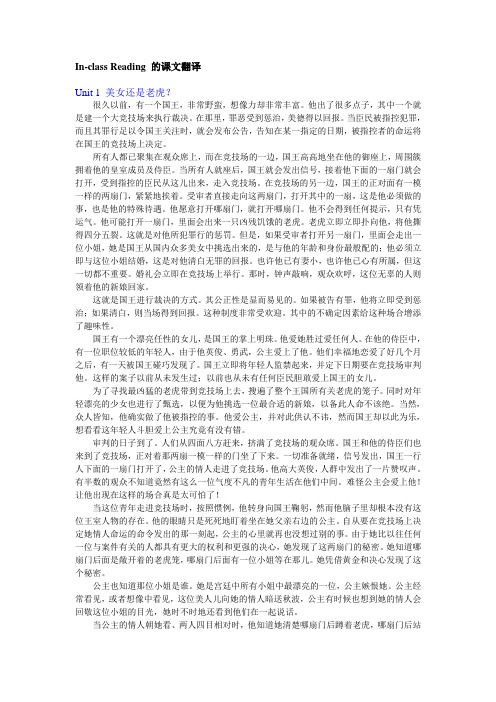
In-class Reading 的课文翻译Unit 1 美女还是老虎?很久以前,有一个国王,非常野蛮,想像力却非常丰富。
他出了很多点子,其中一个就是建一个大竞技场来执行裁决。
在那里,罪恶受到惩治,美德得以回报。
当臣民被指控犯罪,而且其罪行足以令国王关注时,就会发布公告,告知在某一指定的日期,被指控者的命运将在国王的竞技场上决定。
所有人都已聚集在观众席上,而在竞技场的一边,国王高高地坐在他的御座上,周围簇拥着他的皇室成员及侍臣。
当所有人就座后,国王就会发出信号,接着他下面的一扇门就会打开,受到指控的臣民从这儿出来,走入竞技场。
在竞技场的另一边,国王的正对面有一模一样的两扇门,紧紧地挨着。
受审者直接走向这两扇门,打开其中的一扇,这是他必须做的事,也是他的特殊待遇。
他愿意打开哪扇门,就打开哪扇门。
他不会得到任何提示,只有凭运气。
他可能打开一扇门,里面会出来一只凶残饥饿的老虎。
老虎立即立即扑向他,将他撕得四分五裂。
这就是对他所犯罪行的惩罚。
但是,如果受审者打开另一扇门,里面会走出一位小姐,她是国王从国内众多美女中挑选出来的,是与他的年龄和身份最般配的;他必须立即与这位小姐结婚,这是对他清白无罪的回报。
也许他已有妻小,也许他已心有所属,但这一切都不重要。
婚礼会立即在竞技场上举行。
那时,钟声敲响,观众欢呼,这位无辜的人则领着他的新娘回家。
这就是国王进行裁决的方式。
其公正性是显而易见的。
如果被告有罪,他将立即受到惩治;如果清白,则当场得到回报。
这种制度非常受欢迎。
其中的不确定因素给这种场合增添了趣味性。
国王有一个漂亮任性的女儿,是国王的掌上明珠。
他爱她胜过爱任何人。
在他的侍臣中,有一位职位较低的年轻人,由于他英俊、勇武,公主爱上了他。
他们幸福地恋爱了好几个月之后,有一天被国王碰巧发现了。
国王立即将年轻人监禁起来,并定下日期要在竞技场审判他。
这样的案子以前从未发生过;以前也从未有任何臣民胆敢爱上国王的女儿。
为了寻找最凶猛的老虎带到竞技场上去,搜遍了整个王国所有关老虎的笼子。
译林版英语小学五年级上册--课文翻译(英汉对照)

Unit 1 Goldilocks and the three bearsStory time故事时间翻译Goldilocks is in the forest. There is a house.金发姑娘在森林里。
有一所房子。
What a beautiful house!多么漂亮的房子啊!Goldilocks is in the house. She is hungry and thirsty. There is some soup on the table. 金发姑娘在房子里。
她又饿又渴。
桌子上有一些汤。
This soup is too cold.这碗汤太凉了。
This soup is too hot.这碗汤太热了。
This soup is just right.这碗汤正好。
Goldilocks is tired now. There are three beds in the room.金发姑娘现在累了。
房间里有三张床。
This bed is too hard.这张床太硬了。
This bed is too soft.这张床太柔软了。
This bed is just right.这张床正好。
Goldilocks is afraid. There are three bears in front of her!金发姑娘害怕了。
在她前面有三只熊!Who are you?你是谁?Help! Help!救命啊!救命啊!Cartoon time英语课文翻译Bobby is hungry.博比饿了。
I’m hungry, Tina.我饿了,蒂娜。
You can have some cakes. There are some in the kitchen.你可以吃一些蛋糕。
在厨房里有一些。
Bobby is in the kitchen.博比在厨房里。
Where are the cakes, Tina?蛋糕在哪里,蒂娜?They’re in the fridge.它们在冰箱里。
人教版新课标 必修二 翻译 unit 5 FREDDY THE FROG(II)
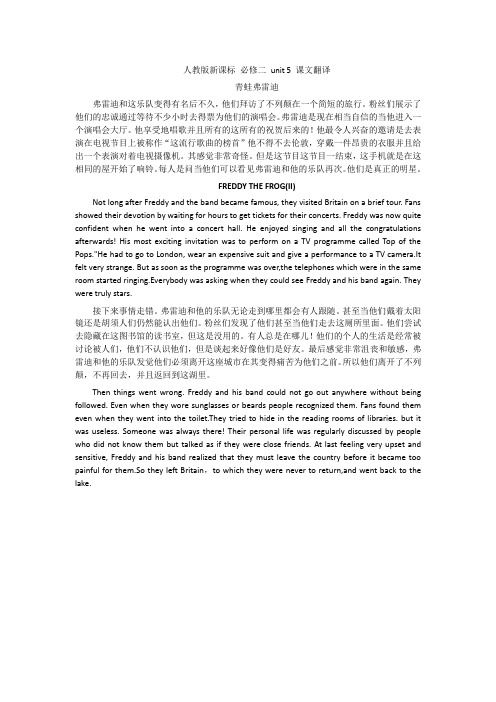
人教版新课标必修二unit 5 课文翻译青蛙弗雷迪弗雷迪和这乐队变得有名后不久,他们拜访了不列颠在一个简短的旅行。
粉丝们展示了他们的忠诚通过等待不少小时去得票为他们的演唱会。
弗雷迪是现在相当自信的当他进入一个演唱会大厅。
他享受地唱歌并且所有的这所有的祝贺后来的!他最令人兴奋的邀请是去表演在电视节目上被称作“这流行歌曲的榜首”他不得不去伦敦,穿戴一件昂贵的衣服并且给出一个表演对着电视摄像机。
其感觉非常奇怪。
但是这节目这节目一结束,这手机就是在这相同的屋开始了响铃。
每人是问当他们可以看见弗雷迪和他的乐队再次。
他们是真正的明星。
FREDDY THE FROG(II)Not long after Freddy and the band became famous, they visited Britain on a brief tour. Fans showed their devotion by waiting for hours to get tickets for their concerts. Freddy was now quite confident when he went into a concert hall. He enjoyed singing and all the congratulations afterwards! His most exciting invitation was to perform on a TV programme called Top of the Pops."He had to go to London, wear an expensive suit and give a performance to a TV camera.It felt very strange. But as soon as the programme was over,the telephones which were in the same room started ringing.Everybody was asking when they could see Freddy and his band again. They were truly stars.接下来事情走错。
unit 5-5比较结构的翻译

I hadn’t the faintest idea what “this matter” was, but I was more annoyed than interested. 我一点儿也不知道“这件事”是指什么, 但我兴趣不大,倒觉得厌烦。 My upbringing had been more that of a wild boy than that of a young lady. 我早年所受的教育,使我不大像一个娇 小姐,倒很像一个也孩子。
下面是一些含有否定比较结构的例子, 注意译文一定要符合汉语的表达习惯。 It is not much more than noon. 刚过晌午。 You are no better than a coward. 你简直就是一个胆小鬼。 The doctor had never seen him in better spirits. 医生从未见他精神头这么好过。 他的精神头出奇地好。
Everyone acknowledges that Newton was a great man; yet few have more than the vaguest acquaintance with his living personality. 大家承认牛顿是一个伟大的人物,但对 于他生前的为人,一般只有一个大概的 了解。
- 1、下载文档前请自行甄别文档内容的完整性,平台不提供额外的编辑、内容补充、找答案等附加服务。
- 2、"仅部分预览"的文档,不可在线预览部分如存在完整性等问题,可反馈申请退款(可完整预览的文档不适用该条件!)。
- 3、如文档侵犯您的权益,请联系客服反馈,我们会尽快为您处理(人工客服工作时间:9:00-18:30)。
English
Form-focused with emphasis on explicit cohesion (显性联接) Hypotactic
ቤተ መጻሕፍቲ ባይዱ
意合型语言
(以意统形)
Compare the sentence structures:
• 我的小孙子/外孙他很 调皮。 • 那所房子你们早该修 了。 • 英语这门语言,学会 它可不容易。 • 这里建大桥,我看行 不通。
Chinese Structure: 话题Topic-Comment 话题-评论
• My little grandson is very naughty. • You should have repaired the house. • It is by no means easy to learn the English language. • I don’t think it workable to build a bridge here.
人到齐就开会。 不要人云亦云。
The meeting will begin when all are here.
Don’t say what others have said. Tense (时态) 帐单撕碎了。 The bill was torn to pieces. 问题解决了。 The problem was solved. Voice (语 态) 你再说一个字, If you should say one more 我马上走。 word, I would go at once. 你死了, If you should die, I would go and 我去当和尚。 be a monk. Mood (语气)
形合型语言
(以形驭意)
Chinese: left-extending(左分支) heavy-headed like a lion(狮子头)
树 一棵树 一棵大树 一棵枝繁叶茂的大树 校园里一棵枝繁叶茂的大树 二师校园里一棵枝繁叶茂的大树 东湖开发区二师校园里一棵枝繁叶茂的大树 ……
English: right-extending (右分支)heavy-tailed like a peacock
Chinese: moving point of sight视点流动
“I can lick you.” “No, you can’t.” “Yes, I can.” “No, you can’t.” “I can.” “you can’t.” “Can!” “Can’t!” 我要揍你。 你敢! 敢又怎么样? 那你就试试吧! 试试?哼,你等着瞧! 等着瞧?我才不怕呢! 不怕,好,那你休想逃走。 谁逃了?来呀,你揍啊!
(Time Order 时间先后 时间先后)
他人老心 不老。
Although he has aged physically, he remains young at heart.
(Concession 让步 让步)
Contrast Between English and Chinese Chinese
English: fixed point of sight 视点固定
“I can lick you.” “No, you can’t.” “Yes, I can.” “No, you can’t.” “I can.” “you can’t.” “Can!” “Can’t!” “我会揍你的。” “不,你不会。” “是的,我会的。” “不,你不会的。” “我会的。” “你不会的。” “会!” “不会!”
Two Types of Transfer
• Negative Transfer (负迁移) Errors arise from analogy. 类推会产生错误。 • Positive Transfer (正迁移) Errors decrease by analysis. 分析能减少错误。
Keen awareness of the similarities and differences between the two languages can facilitate FL learning.
Chinese
Lacking inflection in the strict sense 缺少严格意义的形态 变化 老师们、同学们 我的爸爸、你的妈妈 认真的态度、 认真地学习
English
Retaining some inflections 保留一些形态变化 v.(动词): tense, aspect, voice, mood n.(名词): number, case, gender pron.(代词): person, gender, case, number adj.(形容词): degree ad.(副词) : degree
Categories of texts
Type of writing: Description Narration Exposition argumentation
Requirements for the text: Unity Coherence
Language Transfer and translation
This is the cat. This is the cat that caught the rat. This is the cat that caught the rat that ate the fish. This is the cat that caught the rat that ate the fish that lay in the kitchen. This is the cat that killed the rat that ate the fish that lay in the kitchen that was built by Jack. …
人在阵地在。 The position will not be given up so long as we are still living. 人无远虑, If one has no long-term considerations, 必有近忧。 he will find trouble at his doorstep.
Examples of Negative Transfer
1. The writer likes writing at light (night). 【语音 迁移】 2. He only eat two meal a day. 【词形迁移】
Difference Between
Comparative Study and Contrastive Study Comparative Study lays emphasis on the similarities between languages and applies the diachronic method of research. Contrastive Study lays emphasis on the differences between languages and applies the synchronic method of research.
English: tree-like sentence structure (树式结构)
As a nation of gifted people who comprise about one-fourth of the total population of the earth, China plays in world affairs a role that can only grow more important in the years ahead. -- Jimmy Carter
Trunk line: S + V + (O) Branches and sub-branches : Adverbials and attributes
Rhythmic speech or writing is like waves of the sea, moving onward with alternating rise and fall, connected yet separated, like but different, suggestive of some law, too complex for analysis or statement, controlling the relations between wave and wave, waves and sea, phrase and phrase, phrases and speech. H. W. Fowler (1858 – 1933)
English Structure: Subject-Predicate 主语-谓语 主语-
Contrast Between English and Chinese
Chinese
Topic-Comment Sentence Structure 话题-评论结构 结构) (话题-评论结构)
English
Transfer (迁移)is the influence resulting from the similarities and differences between the target language and any other language that has been previously acquired . Odlin (1989: 27) 迁移是由于目标语与已经习得的语言之间的 相似和差异而产生的影响。 ---奥德林
Subject-Predicate Sentence Structure 主语-谓语结构) (主语-谓语结构)
